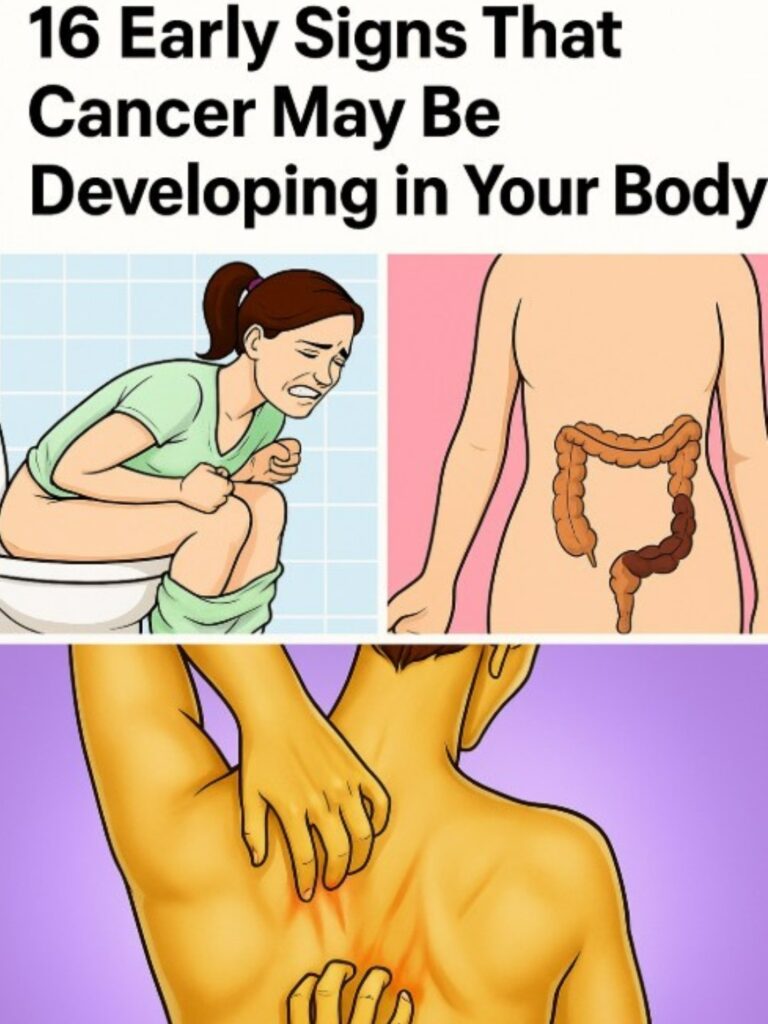
Cancer doesn’t always announce itself with pain.
It doesn’t come with a warning label.
Often, it starts quietly — a small change you brush off as fatigue, aging, or stress.
But sometimes…
that lingering cough isn’t allergies.
That unexplained weight loss isn’t just “finally shedding pounds.”
That lump? It’s worth checking.
Your body speaks in whispers before it screams.
And if you listen early, you could catch something at a stage when treatment works best.
While no single symptom means you have cancer, certain persistent, unexplained changes should never be ignored.
Let’s explore the 16 warning signs doctors say you should take seriously — so you can act wisely, not wait too long.
Because real health isn’t about waiting for pain.
It’s about listening — before silence becomes tragedy.Buy vitamins and supplements
Why Early Detection Matters
✅ Many cancers have no symptoms early on
By the time symptoms appear, cancer may be advanced
✅ Survival rates are much higher when caught early
For example, 5-year survival for localized breast cancer is
99%
vs.
30%
if spread
✅ Some symptoms are subtle and easy to dismiss
Like fatigue, bloating, or skin changes
Regular screenings (mammograms, colonoscopies, Pap tests) are key — but so is paying attention to your body between check-ups.
⚠️ 16 Persistent Symptoms That Deserve Medical Attention
These signs don’t mean you have cancer — but they should be evaluated by a healthcare provider if they last more than 2–3 weeks or get worse.
1. Unexplained Weight Loss
Losing 10+ pounds without trying
Common in pancreatic, stomach, lung, or lymphoma cancers
Not due to diet or exercise? Get it checked.
2. Fever That Won’t Go Away
Low-grade fever lasting days or weeks
May be sign of blood cancers like leukemia or lymphoma
Especially if accompanied by night sweats or fatigue.
3. Extreme Fatigue
Tiredness that doesn’t improve with rest
Can be linked to many cancers, including colon and leukemia
Not normal burnout — this is physical exhaustion.
4. Pain That Persists
Constant back pain (pancreatic, ovarian cancer)
Bone pain (bone or metastatic cancer)
Headaches with vomiting (brain tumors)
⚠️ Pain that wakes you up at night needs evaluation.
5. Skin Changes
Watch for:
New moles or changes in size, shape, color (melanoma)
Yellowish skin (jaundice → liver/pancreatic issues)
Dark patches (acanthosis nigricans → possible internal cancer)
Use the ABCDE rule for moles: Asymmetry, Border, Color, Diameter, Evolving.
6. Sores That Don’t Heal
Mouth ulcers, skin lesions, or genital sores lasting >2 weeks
Could indicate oral, skin, or cervical cancer
Never ignore non-healing wounds.
7. White Patches Inside the Mouth
Leukoplakia — thick, white patches that can become cancerous
Linked to tobacco use or HPV
See a dentist or doctor if persistent.
8. Lump or Thickening Anywhere
Common sites:
Breast
Abdomen
✅ Check regularly. Report any new lump — even if painless.
9. Trouble Swallowing
Feels like food gets stuck
May signal esophageal or throat cancer
⚠️ Worse with solids first, then liquids.
10. Changes in Bowel Habits
Includes:
Persistent diarrhea or constipation
Narrow stools (colon cancer)
Blood in stool (bright red or dark)
Don’t assume it’s hemorrhoids — get tested.
11. Persistent Cough or Hoarseness
Lasting more than 3 weeks
Can be lung cancer or thyroid/laryngeal tumors
❗ Smokers: This is especially urgent.
12. Blood in Urine or Stool
Pink, red, or brown urine = hematuria (bladder/kidney cancer)
Nausea or discomfort after meals
May be stomach or esophageal cancer
Especially if new and persistent.
14. Night Sweats
Drenching sweats unrelated to room temperature
Common in lymphomas and some leukemias
Not menopause or anxiety? Investigate.
15. Breast or Body Changes
Nipple discharge (especially bloody)
Skin dimpling (“orange peel” texture)
Changes in testicles (swelling, heaviness)
✅ Monthly self-checks matter — know what’s normal for you.
16. Neurological Symptoms
Headaches with vision changes
Seizures
Sudden weakness or numbness
Could indicate brain tumor — seek immediate care.
✅ Who Is at Higher Risk?
You can’t control genetics — but knowing your risk helps you act faster.
✅ Age over 50
Most cancers occur in older adults
✅ Family history
BRCA genes, Lynch syndrome, etc.
✅ Smoking
Increases risk of lung, bladder, mouth, and many others
✅ Obesity
Linked to 13 types of cancer
✅ Alcohol use
Raises risk of breast, liver, esophageal cancers
✅ UV exposure
Major cause of skin cancer
✅ HPV infection
Causes cervical, throat, anal cancers
Even without risk factors, cancer can happen.
✅ What You Can Do: Prevention & Early Detection
✅ Know your body
Notice changes early
✅ Get recommended screenings
Mammograms, colonoscopies, Pap smears, PSA tests
✅ Live a low-risk lifestyle
No smoking, limit alcohol, eat well, stay active
✅ Protect your skin
Wear sunscreen, avoid tanning beds
✅ Get vaccinated
HPV vaccine prevents several cancers
✅ See a doctor promptly
Don’t wait for symptoms to worsen
No symptom is too small to ask about.
❌ Debunking the Myths
❌ “Only smokers get cancer”
False — non-smokers get cancer too
❌ “If I feel fine, I’m safe”
Dangerous myth — many cancers show no early symptoms
❌ “Alternative medicine can cure cancer”
False — delays proven treatments; can be deadly
❌ “Screenings cause cancer”
No — benefits far outweigh minimal risks
When to See a Doctor
Seek medical advice if:
A symptom lasts more than 2–3 weeks
It interferes with daily life
You have multiple warning signs
You’re at high risk
Your doctor may order blood tests, imaging, or biopsies — early diagnosis saves lives.
Final Thoughts
You don’t need to live in fear of cancer.
But you should pay attention to what your body tells you.
So next time you’re brushing off a strange ache or odd change…
pause.
Ask yourself:
Has this been going on too long?
Then speak up.
Make the call.
Get checked.
Because real courage isn’t about being fearless.
It’s about caring enough to act — even when you’re afraid.
And that kind of love?
It could save your life — or someone you love.